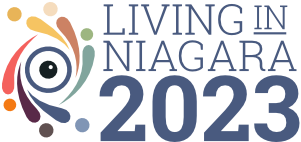In 2016, Niagara Region Public Health created “Niagara’s Village of 100”, an infographic visual representation to better understand the health status of Niagara’s population.
Source: Niagara Region Public Health
Retrieved from: http://www.niagaraknowledgeexchange.com/resources-publications/niagaras-village-of-100/
In 2017, Niagara Region Public Health took a Life Course Approach to analyzing and visualizing Niagara’s Top Health Issues (“Top 10”). Forty-nine thousand lines of data from a variety of sources (Canadian Community Health Survey data, EMS transports, ED visits, Hospitalizations, Reportable infectious diseases and death data) were combined to create a picture of what Niagara’s health issues are by age and stage of life. The main reasons why Niagara residents interact with health services are:
- Cancer
- Circulatory system infections and diseases
- Diabetes
- Digestive system infections and diseases
- Injuries
- Maternal/reproduction
- Mental health (including dementia)
- Poisoning
- Respiratory infections and diseases
- Sexually transmitted infection
The Life Course approach to data visualization:
- Identifies times at which targeted interventions may be especially effective; and
- Enables Niagara Region Public Health to provide services that serve as safety nets and springboards for individuals during key life periods, to alter life course trajectories in a positive way.
Obesity was the number one Self-Reported Condition between 2011 and 2014 for all age groups from 12 to 65 and over. Mental health issues are also of concern (as identified from multiple data sources), throughout the lifespan.
Source: Jan. 31, 2017 “Niagara’s Top Health Issues” Presentation by Medical Officer of Health – Video 00:21:00 to 00:55:00. Niagara Region Public Health and Community Services Committee.
Retrieved from: https://www.youtube.com/embed/7vfauVumkWY?rel=0&autoplay=1
Perceived Ratings of Mental Well-Being and Stress
Public Health Ontario publishes data on the self-reported prevalence of mood and anxiety disorders. The below tables express this data as a percentage of the population.
| Self-Reported Prevalence of Mood Disorders, 2003-2014 | ||||||
| 2003 | 2005 | 2007-08 | 2009-10 | 2011-12 | 2013-14 | |
| Niagara | 5.8% | 6.8% | 7.2% | 8.4% | 8.7% | 9.6% |
| Ontario | 5.5% | 5.9% | 7.1% | 6.7% | 7.4% | 8.4% |
Source: Public Health Ontario. Self-Reported Chronic Health Problems Snapshot.
Retrieved from: http://www.publichealthontario.ca/en/DataAndAnalytics/Snapshots/Pages/Self-Reported-Chronic-Health-Problems.aspx
| Self-Reported Prevalence of Anxiety Disorders, 2003-2014 | ||||||
| 2003 | 2005 | 2007-08 | 2009-10 | 2011-12 | 2013-14 | |
| Niagara | 5.7% | 5.4% | 7.0% | 6.7% | 11.1% | 12.6% |
| Ontario | 4.2% | 4.3% | 5.9% | 5.0% | 6.6% | 7.8% |
Source: Public Health Ontario. Self-Reported Chronic Health Problems Snapshot.
Retrieved from: http://www.publichealthontario.ca/en/DataAndAnalytics/Snapshots/Pages/Self-Reported-Chronic-Health-Problems.aspx
In 2016, a webinar hosted by Niagara Connects provided results of a study that assessed the relationship between REACT a youth-led engagement program that is part of the Chronic Disease and Injury Prevention Division at Niagara Region Public Health, and mental well-being protective factors. Presenters explored how a youth-led engagement program operates, components of a youth-led engagement program that are associated with positive health outcomes for youth participants, and the value of investing in youth-led engagement as a strategy to reach organizational and societal level outcomes.
Source: Mental Well-Being and Youth-Led Engagement in Niagara – Event Recording
Retrieved from: http://www.niagaraknowledgeexchange.com/resources-publications/mental-well-being-and-youth-led-engagement-in-niagara-exploring-the-relationship-event-recording/
The Mental Health and Addictions Access Line , launched in 2014, was created to provide a “one call, one number” approach, serving as the first point of access to local services within Niagara for individuals 16 and up. The 24/7 program is available to:
- help determine the most appropriate service based on individual needs;
- provide immediate support;
- link to service via a warm transfer; and
- follow up to ensure individuals are connected to service.
This collaborative project is a partnership of 16 local mental health and addictions service providers, working together to exemplify the principles of partnership, knowledge exchange, information, and individual and family centred services laid out in Niagara’s Mental Health and Addictions Charter.
Source: Mental Health and Addictions Access Line in Niagara: Helping Our Community Navigate Services in Niagara
Retrieved from: http://www.niagaraknowledgeexchange.com/community-blog/mental-health-and-addictions-access-line-in-niagara-helping-our-community-navigate-services-in-niagara/
Distress Centre Niagara reports the following statistics to demonstrate impact of the Mental Health and Addictions Access Line http://accesslineniagara.com/ in Niagara between May 2014 and September, 2017:
- Over 5,790 registered individuals served since launch in May 2014, with over 2660 calls
- Over 3,000 individuals warm transferred to a mental health or addictions service provider
- Over 87% of callers were connected within 1 day
- Over 4,730 callers indicate they feel better at the end of the call
- Over 2,500 follow up contacts have been made with the partner agencies to confirm client connections
Source: Distress Centre Niagara
Niagara Suicide Prevention Coalition:
The Niagara Suicide Prevention Coalition (NSPC) was formed in 2003 by over 25 community agencies and members at large, to respond to an increase in deaths by suicide in the Niagara region. NSPC exists to bring interested community organizations, groups, individuals and volunteers together to make Niagara a suicide-safer community.
In 2017, the NSPC training subcommittee formed a Community of Practice (CoP) for safeTALK and ASIST trainers across Niagara. The CoP held 2 CoP sessions in 2017 and aims to hold a spring and fall session annually. The focus is to bring trainers together, share information and offer professional development opportunities based on trainer needs.
NSPC ‘s strategic focus for 2018 includes working to enhance the capacity of local service providers to address the issue of suicide in their work; and educating the Niagara community about suicide and pathways to care for those directly affected by suicide. For addition information and resources please visit NSPC website at http://www.niagarasuicidepreventioncoalition.com/
In a January, 2015 webinar attended by 99 people and hosted by Niagara Connects, NSPC outlined 6 action steps to make Niagara a Suicide Safer Community: collective data-sharing; partnerships and collaboration; prevention work including SafeTALK; community protocols; crisis services; and support for postvention services.
Retrieved from: http://www.niagaraknowledgeexchange.com/community-blog/do-you-have-what-it-takes-to-help-make-niagara-a-suicide-safer-community/ and http://www.niagaraknowledgeexchange.com/resources-publications/making-niagara-a-suicide-safer-community-event-recording/
On Sept 2, 2015 NSPC and Niagara Connects hosted a webinar titled, “The Impact of SafeTALK Training on Suicide Prevention and a Culture of Health and Safety in Niagara”. Ninety (90) participants from over thirty-five (35) different organizations participated in the webinar. Key results from the Niagara- wide safeTALK evaluation were shared.
The following next steps were highlighted:
- Encourage employers to leverage safeTALK training as part of health and safety training in Niagara – incorporate it through the National Standard of Psychological Health and Safety in the Workplace
- Advocate for safeTALK to be promoted as a standard of practice for workplaces, similar to that of CPR and First Aid
- Celiver safeTALK training to as many people as possible in Niagara – to support building suicide safer communities
- Build a Community of Practice for safeTALK trainers Niagara – to continue to collaborate and share knowledge and experiences with each other.
MCRRT and COAST:
CMHA (Canadian Mental Health Association) Niagara Branch provides information about two programs that support individuals experiencing a mental health crisis. CMHA works with the Niagara Regional Police Service (NRPS) to deliver the COAST (Crisis Outreach and Support Team) service and MCRRT (Mobile Crisis Rapid Response Team) service.
| MCRRT Service and COAST Service
for Adults in Mental Health Crisis in the Niagara region |
|
| MCRRT
(Mobile Crisis Rapid Response Team) |
COAST
(Crisis Outreach and Support Team) |
| Uniformed CIT police officer and mental health professional in police cruiser | Plain-clothed CIT police officer and mental health professional in unmarked vehicle |
| First response team | Secondary response team |
| Dispatched from 911 | 24/7 Crisis Line |
| Mobile from 12 a.m. to 12 p.m. | Mobile from 11 a.m. to 7 p.m. |
| Provide follow up to police interactions | |
Mobile Crisis Rapid Response Team (MCRRT) is a first response unit service that includes a mental health worker riding alongside an officer, responding to 9-1-1 calls related to mental health. In March, 2017, CMHA (Canadian Mental Health Association) Niagara Branch and the Niagara Regional Police Service (NRPS) expanded MCRRT services, with funding from the Hamilton Niagara Haldimand Brant Local Health Integrated Network (HNHB LHIN).
MCRRT Hours: 12:00 pm (Noon) – 12:00 am (Midnight), 7 days per week
Location: St. Catharines & Thorold
- Provides a quick connection to a mental health worker on emergency service calls
- Offers community based mental status and risk assessments
- Offers hospital and criminal justice system diversion as appropriate
- Connects individuals to appropriate community based services
The team is dispatched through Niagara Regional Police 9-1-1 Emergency Service.
CMHA Niagara Branch reports that the MCRRT target for 2016-17 was 290 individuals; the actual number of individuals served was 596. Thus the 2016-17 target was exceeded by 205%. Of those 596 individuals served, 65% were diverted from the hospital.
| Mobile Crisis Rapid Response Team (MCRRT) Statistics
Canadian Mental Health Association (CMHA) Niagara Branch |
||||||
| Year | Contacts | Individuals Served | Referrals | Connections to Service | Diversions from Hospital | Average Response Time |
| 2015-2016 | 540 | 427 | 497 | 357 | 379 | 7 min 38 sec |
| 2016-2017 | 824 | 596 | 985 | 604 | 537 | 8 min 14 sec |
Source: CMHA Niagara Branch, 2017. [data files]
| COAST (Crisis Outreach and Support Team) Niagara
CMHA (Canadian Mental Health Association) Niagara Branch Statistics |
|||
| Most Frequent Referral Sources | Number of Referrals/ Occurrences | ||
| 2014-15 | 2015-16 | 2016-17 | |
| Police | 1488 | 1658 | 2348 |
| Client/Family | 984 | 986 | 955 |
| Clients’ Community | 102 | 65 | 76 |
| Hospital | 13 | 6 | 9 |
| Total Referrals | 3298 | 3388 | 4125 |
| # unique clients served* | 2589 | 2719 | 3408 |
Crisis Outreach and Support Team (COAST) service in Niagara began in November, 2011. COAST offers 24/7 telephone support through their crisis line at 1-866-550-5205 ext. 1. Trained mental health professionals provide therapeutic intervention over the phone to individuals in crisis across the Niagara Region, to prevent calls to emergency services and visits to the hospital. COAST also offers in person Crisis Outreach with a trained Mental Health Worker and Non-Uniform Police Officer. This team is available daily from 11 am to 7 pm across the region. The COAST team triages situations of elevated risk that do not meet the criteria for 911 and require more than phone support. The COAST outreach team will meet with individuals in crisis and when appropriate their families, to provide support, obtain information, and assess the individual’s current stressors, coping strategies, needs and risk. The team helps to connect individuals to appropriate supports within the community. In the 2016-2017 fiscal year COAST served 3408 individuals.
Source: CMHA Niagara Branch, 2017. [data files]
The above information is also included in the Crime, Safety and Security Sector of this report.
Opioid Overdose:
Niagara Health reports that from January to August 2017 there was a 65% increase in opioid overdose cases presenting in Niagara emergency rooms over the same time frame in 2016. Positive Living Niagara’s StreetWorks program, which distributes naloxone, reports that for the entire year of 2016 there were 147 occasions a kit was used to reverse an overdose. Already in the first half of 2017, there were 190 kits reported used in an emergency opioid overdose situation.
Source: Niagara Region Public Health
Retrieved from: https://www.niagararegion.ca/living/health_wellness/alc-sub-abuse/drugs/opioids.aspx
Overdose prevention information is available from Niagara Region Public Health at: https://www.niagararegion.ca/living/health_wellness/alc-sub-abuse/drugs/overdose-prevention.aspx
Overdose prevention and response information is available from Positive Living Niagara at: http://positivelivingniagara.com/community/reduce-your-risk/overdose-prevention-response/
This information is also included in the Crime, Safety and Security Sector of this report.
Child and Youth Mental Health in Niagara:
From April 1st 2016 to March 31st, 2017 a total of 3,450 children and youth were referred for Ministry of Children and Youth funded children’s mental health, developmental and/or autism services in the Niagara region.
| # of Intakes Completed and Referred for Services | # Unique Children/Youth | Case notes
Completed |
|
| 2016/17 | 4,054 | 3,450 | 19,021 |
| 2015/16 | 3,471 | 2,947 | 17,553 |
| 2014/15 | 2,671 | 2,307 | 12,274 |
| 2013/14 | 2,414 | 2,185 | 8,069 |
Source: Contact Niagara
Retrieved from: http://www.contactniagara.org/en/publications
The Integrated Transitional Age Youth Planning process supports youth transitioning to adult developmental services, and has been in full implementation in Niagara since fall 2014. TAY planning involves youth, their families, community organizations, schools and others in developing a single plan that identifies a youth’s goals, and the steps they feel are important to help attain them. The TAY process begins after a youth turns 14 years old, until the anticipated time of leaving school.
Source: Contact Niagara
Retrieved from: http://www.edu.gov.on.ca/eng/general/elemsec/speced/special_ed_update.html#_Toc445455685
As part of the implementation of Moving on Mental Health in Niagara, Niagara’s core mental health services for children and youth (Niagara Health, Pathstone Mental Health, Centre de santé communautaire, Contact Niagara and N-TEC), with other community partners (schools, youth justice, health) have been working together with youth and families to improve access and programming experiences for those children and youth seeking mental health supports.
Source: Contact Niagara
Retrieved from: http://www.children.gov.on.ca/htdocs/English/professionals/specialneeds/momh/moving-on-mental-health.aspx
In 2016, the Provincial Government began the staged implementation of the new Ontario Autism Program (OAP) for those children and youth birth to 18 years diagnosed with Autism Spectrum Disorder (ASD). The new program includes an ever-increasing focus on family engagement and supports.
Source: Contact Niagara
Retrieved from: http://www.children.gov.on.ca/htdocs/English/specialneeds/autism/ontario-autism-program.aspx
The Ontario Special Needs Strategy is a provincial multi-sector initiative which involves the Integrated Delivery of Rehabilitation Services (led by the Niagara Children’s Centre in Niagara) and enhanced Coordinated Service Planning.
Source: Contact Niagara
Retrieved from: http://www.children.gov.on.ca/htdocs/English/professionals/specialneeds/strategy.aspx
Obesity Rates in Niagara
The tables below highlight overweight and obesity rates in Niagara and Ontario, as a percentage of the population. Detailed data about youth and adult obesity, in addition to health behaviours, is available at the source listed.
| Self-Reported Adult Overweight Rate, 2003-2014 | ||||||
| 2003 | 2005 | 2007-08 | 2009-10 | 2011-12 | 2013-14 | |
| Niagara | 32.8% | 33.1% | 34.4% | 34.5% | 38.2% | 29.5% |
| Ontario | 33.8% | 33.8% | 33.8% | 33.2% | 33.3% | 33.8% |
Source: Public Health Ontario. Self-Reported Nutrition and Healthy Weights Snapshot.
Retrieved from: http://www.publichealthontario.ca/en/DataAndAnalytics/Snapshots/Pages/Health-Behaviours—Nutrition-and-Healthy-Weights.aspx
| Self-Reported Adult Obese Rate, 2003-2014 | ||||||
| 2003 | 2005 | 2007-08 | 2009-10 | 2011-12 | 2013-14 | |
| Niagara | 16.7% | 19.9% | 18.3% | 19.7% | 17.4% | 22.1% |
| Ontario | 15% | 15.1% | 16.7% | 17.6% | 17.8% | 18.4% |
Source: Public Health Ontario. Self-Reported Nutrition and Healthy Weights Snapshot.
Retrieved from: http://www.publichealthontario.ca/en/DataAndAnalytics/Snapshots/Pages/Health-Behaviours—Nutrition-and-Healthy-Weights.aspx
Healthy Kids Community Challenge: Niagara is one of 45 communities across Ontario taking part in The Healthy Kids Community Challenge (HKCC). The goal of HKCC is to link organizations from different sectors in the community to promote the health of children aged 12 years and under and accomplish the Ontario Government’s Healthy Kids Strategy to reduce childhood obesity rates.
With $1.125M in funding, partners from different sectors are joining forces to deliver interventions focused on one specific theme every nine months over three years. Theme One – Run. Jump. Play. Every day. was aimed to encourage daily physical activity and making Niagara a community where it’s easy for kids to be active. Theme 2 – Water Does Wonders focused on promoting water consumption; encouraging kids and families to make water their first drink of choice and to reduce their consumption of sugar-sweetened beverages. Theme 3 – Choose to Boost Veggies and Fruit encourages kids and families to reach for more vegetables and fruit.
Source: Healthy Kids Community Challenge Niagara c/o Niagara Region Public Health
Retrieved from: http://www.niagaraknowledgeexchange.com/partners-projects/niagara-healthy-kids-community-challenge/
Prevalence Rates of Chronic Conditions in Niagara
The table below highlights the rates of five common chronic conditions in the Niagara Regional Area Health Unit. Figures are expressed as a percentage of the population and are based on self-reporting.
| Self-Reported Prevalence of Chronic Conditions, Niagara Regional Area Health Unit, 2003-2014 | ||||||
| 2003 | 2005 | 2007-08 | 2009-10 | 2011-12 | 2013-14 | |
| Asthma | 7.7% | 9.5% | 10% | 9.1% | 9.5% | 9.1% |
| Diabetes | 3.2% | 5.3% | 4.1% | 5.8% | 6.6% | 5.7% |
| Heart disease | 5.2% | 4.8% | 5.2% | 4.4% | 6% | 3.1% |
| High blood pressure | 14.2% | 14.2% | 13.3% | 15.9% | 14.4% | 14.7% |
Source: Public Health Ontario. Self-Reported Chronic Health Problems Snapshot.
Retrieved from: http://www.publichealthontario.ca/en/DataAndAnalytics/Snapshots/Pages/Self-Reported-Chronic-Health-Problems.aspx
A stroke happens when blood stops flowing to any part of the brain, damaging brain cells. The effects of a stroke depend on the part of the brain that was damaged and the amount of damage done.
Source: Heart and Stroke Foundation. What is Stroke?
Retrieved from: https://www.heartandstroke.ca/stroke/what-is-stroke
The Canadian Institute for Health Information defines a Hospitalized Stroke Event as a new stroke event resulting in the individual being admitted to an acute care hospital (18 years of age and older). A new stroke event is a first-ever hospitalization for stroke or a recurrent hospitalized stroke occurring more than 28 days after the admission for the previous stroke event. Rates are per 100,000 population.
| Hospitalized Stroke Events Per 100,000 Population, 2013-2015 | |||
| 2013 | 2014 | 2015 | |
| Niagara | 138 | 138 | 151 |
| Ontario | 116 | 100 | 135 |
Source: Canadian Institute for Health Information. Health Indicators Interactive Tool.
Retrieved from: https://yourhealthsystem.cihi.ca/epub/search.jspa
Acute Myocardial Infarctions are commonly known as heart attacks, which occur when the flow of blood to the heart becomes blocked, usually through a blockage in one or more of the coronary arteries. They can cause tissue damage and can be life-threatening.
Source: Healthline. Acute Myocardial Infarction.
Retrieved from: https://www.healthline.com/health/acute-myocardial-infarction#overview1
The Canadian Institute for Health Information defines a Hospitalized Acute Myocardial Infarction (AMI) Event as a new AMI event resulting in the individual being admitted to an acute care hospital (18 years of age and older). A new AMI event is a first-ever hospitalization for AMI or a recurrent hospitalized AMI occurring more than 28 days after the admission for the previous AMI event. Rates are per 100,000 population.
| Hospitalized Acute Myocardial Infarction Events Per 100,000 Population, 2013-2015 | |||
| 2013 | 2014 | 2015 | |
| Niagara | 346 | 303 | 282 |
| Ontario | 243 | 237 | 226 |
Source: Canadian Institute for Health Information. Health Indicators Interactive Tool.
Retrieved from: https://yourhealthsystem.cihi.ca/epub/search.jspa
Other leading causes of hospitalization which indicate the presence of chronic disease in the community can be found on the Niagara Region Public Health website at the following link.
Source: Niagara Region Public Health. Leading Causes of Hospitalization – Statistics in Niagara.
Retrieved from: https://www.niagararegion.ca/health/statistics/injury-death/hospitalization.aspx
HNHB LHIN Caring for My COPD Program:
Caring for My COPD is a community-based program designed to enhance quality of life for people with Chronic Obstructive Pulmonary Disease (COPD).
- In the HNHB LHIN, 1 in 10 people over the age of 35 has COPD.
- In the HNHB LHIN, 1 in 5 people is readmitted to hospital for COPD within 30 days of discharge, and 1 in 3 is readmitted within 90 days.
- Difficulty breathing due to COPD is a leading cause of emergency department visits and hospitalizations in the HNHB LHIN and Canada.
The Niagara Falls Community Health Centre and the Centre de sante communautaire in Welland offer the 10-week Caring for My COPD (Chronic Obstructive Pulmonary Disease) program. In the Hamilton Niagara Haldimand Brant Local Health Integration Network (HNHB LHIN) area, 1 in 10 people over age 35 has COPD; and difficulty breathing due to COPD is a leading cause of emergency department visits and hospitalization.
Source: HNHB LHIN
Retrieved from: http://bit.ly/1ut4oGk
Injury Rates
The following table highlights emergency department visits for all injuries, per 100,000 population, in Niagara and Ontario. These figures are inclusive of those injuries that are intentional and unintentional. Detailed data by type of injury is available at the source listed.
| Emergency Department Visits for All Injuries Per 100,000 Population, 2010-2015 | ||||||
| 2010 | 2011 | 2012 | 2013 | 2014 | 2015 | |
| Niagara | 12,199.8 | 11,917.3 | 12,347.3 | 11,594.9 | 12,055.8 | 12,230.2 |
| Ontario | 9,902 | 9,825.2 | 9,965.8 | 9,943.9 | 9,976.6 | 10,030.8 |
Source: Public Health Ontario. Emergency Department Visits for Injuries Snapshot.
Retrieved from: http://www.publichealthontario.ca/en/DataAndAnalytics/Snapshots/Pages/Injury-ED-Visits.aspx
Niagara Region Public Health provides Injuries – Statistics in Niagara at this link: https://www.niagararegion.ca/health/statistics/injury-death/injuries.aspx
Cancer Rates in Niagara
The following tables describe cancer incidence and mortality rates in the Niagara Regional Area Health Unit and Ontario. Incidence rates include occurrences of all malignant cancers, per 100,000 population. A more detailed breakdown of rates, including those by specific types of cancer, is available at the source listed.
| Incidence of All Malignant Cancers Per 100,000 Population, 2007-2012 | ||||||
| 2007 | 2008 | 2009 | 2010 | 2011 | 2012 | |
| Niagara | 424.3 | 421.1 | 421.4 | 457.6 | 454.9 | 429.2 |
| Ontario | 416.9 | 406.4 | 407.1 | 421 | 428.2 | 413 |
Source: Public Health Ontario. Cancer Incidence Snapshot.
Retrieved from: http://www.publichealthontario.ca/en/DataAndAnalytics/Snapshots/Pages/Cancer-Incidence-.aspx
| Mortality from All Malignant Cancers Per 100,000 Population, 2007-2012 | ||||||
| 2007 | 2008 | 2009 | 2010 | 2011 | 2012 | |
| Niagara | 233.6 | 231.2 | 239 | 223.9 | 221.1 | 222 |
| Ontario | 216.7 | 214.9 | 210.2 | 208.4 | 205.8 | 201.8 |
Source: Public Health Ontario. Cancer Mortality Snapshot.
Retrieved from: http://www.publichealthontario.ca/en/DataAndAnalytics/Snapshots/Pages/Cancer-Mortality.aspx








